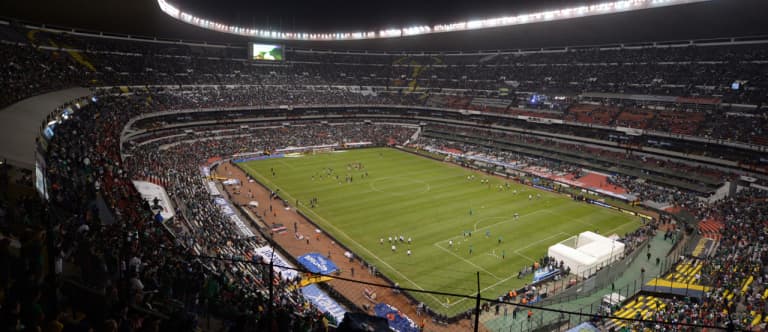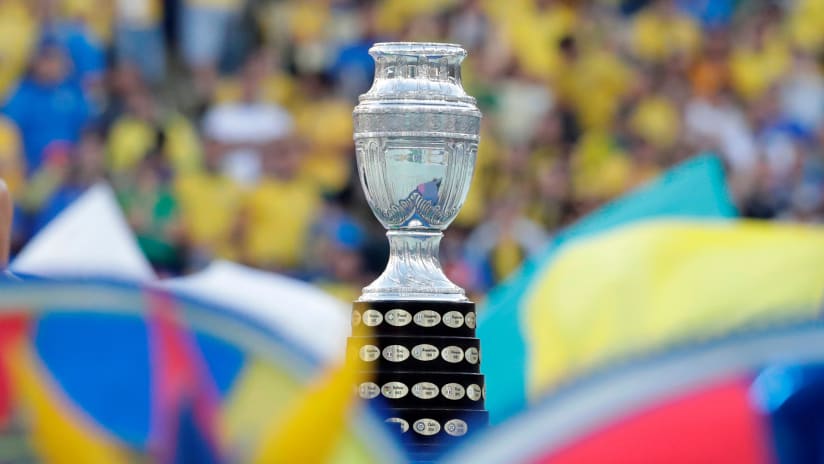When it comes to home-field advantage, Mexico just might have it best.
Mexico play their home games at Estadio Azteca, the vaunted, imposing venue that's long spelled doom for many a CONCACAF foe. Located in the neighborhood of Santa Úrsula in Mexico City, Azteca is more a stronghold than a stadium because of its brawny architecture and size, big enough to hold more than 100,000 fans.
Two hours before an important game – in time for when visiting players have arrived at the stadium and start checking out the field in street clothes – the stadium is already full, buzzing like a beehive.
“That’s something I’ve never seen before,” said Philadelphia Union forward Charlie Davies, who played and scored at Azteca while with the US national team in a World Cup qualifier in 2009.
Since the Azteca opened in 1966, the Mexicans have rarely been defeated at home in World Cup Qualifying – just twice in 49 matches, to be exact. They boast a monstrous winning record of 40-2-7.
Next up to test their luck – yes luck, for luck does play a part in this unusual venue – are the US on Sunday evening, in another World Cup qualifier (8:30 pm ET | FS1, Univision, UDN). Another enormous, inimical crowd will fill the Azteca, and it'll be another huge task for the visiting team.
The US have fared better than most at Azteca, but not by much. In 12 games, friendly and official, their record is 1-9-2. But however difficult the environment, don’t expect the Americans, with their experienced roster, to feel daunted.
Sporting Kansas City defender Matt Besler – who is in the US squad for the upcoming match and played the full 90 minutes in the last World Cup qualifying meeting there – says that he’s excited to play at the historic stadium again and that he’s not alone in feeling that way.
“Even if it’s a difficult challenge, these are the games that you’ll remember and these are the games that are going to push you to the limit, both individually and as a team,” Besler said. “These types of games are the ones that you get up for.”
Besler added that the US players and staff didn’t talk about the looming Mexico game for “more than one second” in the buildup to their 2-0 qualifying win against Trinidad and Tobago in Colorado on Thursday night, but there’s no question that playing a game at Azteca requires advanced preparation.
A former US player and MLS coach, Frank Klopas never got a chance to play at Azteca but does know what it means to prepare a team for a game there. Leading the Montreal Impact to the CONCACAF Champions League final against Club America in 2015, Klopas called erstwhile US coach Jurgen Klinsmann to ask for advice, especially with regards to the biggest challenge that playing at Azteca presents: its high elevation of 7,200 feet above sea level.
There are different strategies for handling the altitude, but the prevalent ones are twofold: either you arrive the day before the game, so that your body hasn’t had a chance to fully register it, or you get there very early to acclimate. The Impact chose the latter and handled themselves superbly in a 1-1 draw against Club America.
The US will only be able to arrive in Mexico City on Friday, but have spent the last 10 days at high altitude, first training in Colorado, then playing against Venezuela in a friendly at Rio Tinto Stadium in Salt Lake City before returning to Colorado to play Trinidad & Tobago at Dick's Sporting Goods Park.
That should help the Americans' cause, even if Azteca is still significantly higher than those places. Rio Tinto Stadium sits at 4,500 feet and Dick Sporting Goods Park is at 5,200 feet.

Azteca offers other surprises and difficulties. Klopas noted that you can’t see how big the stadium is from the street when driving to the stadium, because it’s partly dug underground. It is only when you walk down into the stadium, through the dark cave-like tunnel, past the large glass-encased photos that are arranged in chronological order of all the great events that the stadium has hosted – the 1970 World Cup final with Pele and the 1986 World Cup final with Maradona, for instance – and then up through the spiral staircase, that you really meet the giant.
And suddenly, you might find it hard to breath. Not because you’re so taken in by the place – although that might be a reason, too – but because of the stadium’s poor air circulation. Making matters even worse is that the air itself, due to the city’s dreadful smog, is of poor quality to begin with.
“When I walked out onto that pitch for the game, and we were setting up the pitch for training, it was so hard to breath that I just said, ‘Man, I know what they’re talking about now, the big advantage teams have here.’” Klopas said. “No matter what you do, the preparation and everything, you can never prepare for it 100 percent.”
Davies gets goosebumps just recalling the game in 2009, which ended 2-1 in Mexico's favor. For the 30-year-old forward – who was then 23 – it felt like he was playing in a coliseum. One thing that he remembers clearly was coming back downstairs after warm-ups.
“I knew it was serious when we had oxygen tanks at everyone’s locker before the game,” Davies said. “I was like, 'This is pretty intense.' I didn’t really think elevation could affect you that much, and after the match I thought, ‘I was completely wrong.’”
The US players usually take oxygen before the game starts and at halftime. Especially in the second half or after a long sprint, it can often feel like you’re not getting the oxygen you need, even as you take bigger and bigger breaths.
Every player is different, however, and former US defender Alexi Lalas explained that some players cope better than others. Midfielder Cobi Jones, Lalas remembers, was one who had particular difficulty playing at Azteca, especially during the 1993 Gold Cup final. Mexico thrashed the Americans 4-0 that day.
“I’ll never forget the image of Cobi Jones when we came in at halftime. And Cobi was a guy who had some breathing problems,” Lalas said. “He had an inhaler with him so he was always on that regardless of where we were playing, and I’ll never forget sitting down next to him and seeing him summon from the depths of hell in his bowels, or wherever in his stomach, this disgusting globule of phlegm and he just hawked this thing up which was just disgusting black. It was as if he had been in a coal mine for 40 years.”
Although the air quality has improved since, the elevation still causes the ball to travel about 3-5 yards more when played in the air, something which Besler said the US have worked on in Colorado.
But another major challenge of playing at Azteca is the opponent. Mexico are one of the best sides in CONCACAF, “if not the best”, according to Lalas. And then there’s the vociferous crowd support. The steep stands make it seem like the fans are going to fall on top of you, and the Mexican players are adept at using the crowd to their advantage.
The US's record at Azteca might not be all that great, but they are undefeated in their last two encounters there – a historic 1-0 win in a friendly in 2012 and the 0-0 tie in 2013. As Davies noted, scoring a goal can really help silence the crowd – and even sometimes turn the home crowd against their own players. Lalas, meanwhile, stressed the luck factor: there’s the referee to consider, or maybe you’ll get bounces or fortuitous deflections in your favor.
Of course, things can also go the other way, but there is a feeling from some observers that Azteca has maybe lost some of its luster. There has even been talk in Mexico of the possibility of moving home games elsewhere.
Nonetheless, the US expect Mexico to approach this game with extra intensity.
“I would guess that Mexico is going to be aware that the last two times we came into Azteca we have gotten the win and the draw,” Besler said. “So I expect them to come out [strong], because they’ll wanna make sure that doesn’t happen again.”
ExtraTime Radio Podcast














